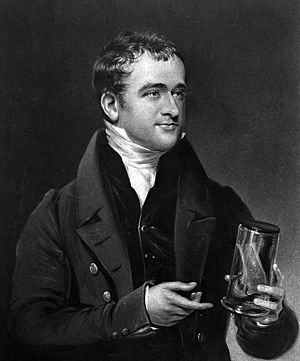Herbert Mayo facts for kids
Quick facts for kids
Herbert Mayo
|
|
|---|---|

Herbert Mayo c. 1830
|
|
| Born | 3 April 1796 London, United Kingdom
|
| Died | 15 May 1852 (aged 56) Bad Weilbach, Germany
|
| Nationality | British |
| Occupation | Physician |
| Known for | Medical writings |
Herbert Mayo (born April 3, 1796 – died May 15, 1852) was a British doctor, anatomist, and writer. He was known for his important work in understanding the human body, especially how nerves function.
Contents
Herbert Mayo's Life and Work
Early Life and Education
Herbert Mayo was born in London, England. He was the third son of a doctor named John Mayo. From a young age, he showed an interest in medicine.
He began his medical training at Middlesex Hospital in 1814. He also studied at Leyden University, where he earned his medical degree. By 1818, he became a house-surgeon at Middlesex Hospital.
Discoveries About Nerves
In 1822, Mayo published his findings on how the nerves in the face work. He explained that different nerves control different actions. For example, one nerve helps you move your face, while another helps you feel things.
This discovery was very important for understanding the human nervous system. It led to some debate with another famous doctor, Sir Charles Bell. However, many experts agree that Mayo helped complete the understanding of these nerves. His work made it clear which nerves were responsible for movement and which for feeling in the face.
Teaching and Later Career
Herbert Mayo was also a dedicated teacher. He gave lectures on anatomy and physiology. In 1827, he published Outlines of Human Physiology, a book based on his lectures.
He worked as a surgeon at Middlesex Hospital for many years. He also became a professor of anatomy and surgery at the Royal College of Surgeons. When King's College London opened in 1830, he became a professor there too.
Later in his life, Mayo faced health challenges. He moved to Germany, where he found relief from his illness. He continued to work as a doctor there until he passed away in 1852. He also wrote a book called Truths contained in Popular Superstitions, where he shared his thoughts on different beliefs.
His Important Books
Herbert Mayo wrote many books that helped people understand the human body and health. Some of his well-known writings include:
- Anatomical and Physiological Commentaries, 1822–3.
- Course of Dissections for Students, 1825.
- Outlines of Human Physiology, 1827–1837 (published in four editions).
- A Series of Engravings of Brain and Spinal Cord in Man, 1827.
- Outlines of Human Pathology, 1836.
- Management of Organs of Digestion, 1837 and 1840.
- Powers of the Roots of the Nerves in Health and in Disease, 1837.
- Philosophy of Living, 1837 and 1851.
- Nervous System and its Functions, 1842.
- The Cold Water Cure, 1845.
- Letters on Truths in Popular Superstitions, 1848 and 1851.

